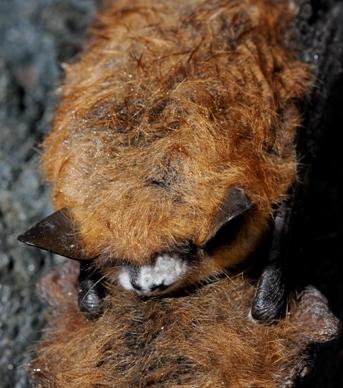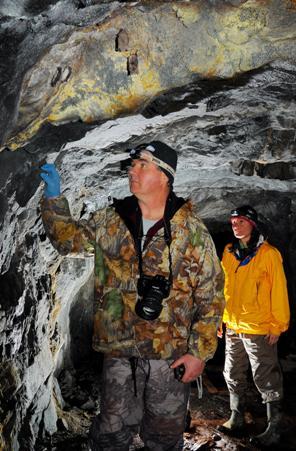White-nose Syndrome (WNS) is the descriptive term given to a condition first observed in bats hibernating in a cave near Albany, NY in February 2006. The term comes from the fact that some of the bats with this condition look like they dipped their faces in powdered sugar. The white powdery substance on their faces is a fungus. On closer examination, this white fungus can also be seen on the bare skin of their ears and wings. In 2009, this fungus was described as a newly discovered species and named Geomyces destructans to highlight the harm that it is causing to North American bats. The fungus is now known as Pseudogymnoascus destructans, or Pd. This fungus grows best in cool temperatures and high humidity, similar to the conditions found in bat winter hibernation sites, like caves.
Ordinarily, bats that hibernate over the winter have enough fat to last them until they emerge in late April and early May. In the spring, there are ample numbers of insects to eat so the bats can replenish their energy reserves. However, at caves and mines with WNS, some of the hibernating bats use up their precious fat reserves by early February. They can be seen flying outside in the daytime in a desperate attempt to find something to eat. This is because the aggressive fungus rouses the bats and increases their metabolism. The fungus also irritates their skin, creating holes in the wings of bats leading to dehydration. Unfortunately, any bat that runs out of stored body fat too early or leaves its hibernation site when nighttime temperatures are still below freezing, ultimately starves to death.
At the largest Massachusetts bat hibernation site in an abandoned mine in Chester, there were about 10,000 little brown bats in early winter 2007/08. By the end of winter 2008/09, nearly every bat had been killed by WNS and only 14 individual bats remained. The population at this mine has since risen to about 30 individuals. This indicated there has been some level of recovery from WNS, but this will be a very slow recovery and will include bats that have some level of natural immunity.
WNS continues to spread rapidly and has caused a catastrophic mortality of bats that spend the winter in caves and mines. By 2009, nearly half a million bats had died from WNS in the northeastern states from Vermont south to Virginia. By 2013, over 2 million bats had died at sites from eastern Canada, south to Alabama, and west to Oklahoma. As of October 2018, WNS has been confirmed in 33 states and 7 Canadian provinces, and the disease is estimated to have killed 6.7 million bats since 2006. At this point, no one knows how to stop or even slow the continuing spread of WNS. No one can predict just how far it will eventually go and how many bats will die in the process.
WNS is the number one threat to bats, killing more than a million bats each year and causing mortality rates that approach 100% at some sites. As WNS continues to spread across the United States, scientists predict that the once abundant and widespread little brown bat will be reduced to just 1% of its pre-WNS population by 2030. Scientists also believe WNS has caused the most dramatic decline in North American wildlife in over 100 years since the extinction of the passenger pigeon.
As a result of the devastating mortality that has resulted from WNS in Massachusetts, all 4 of our bat species that spend the winters in caves or mines have been listed as endangered on the Massachusetts Endangered Species List. This includes the little brown bat, which used to be the most abundant and widespread bat species in Massachusetts. Since the onset of WNS in Massachusetts, the state's population of little brown bats has dwindled to less than 1% of what it once was. The other species are the northern long-eared bat, eastern small-footed bat, and tricolored bat (formerly known as the eastern pipistrelle). The Indiana Bat was already listed as endangered as a result of impacts from the pesticide DDT, and was last seen in the Chester mine in 1939. The only 2 Massachusetts bats that have summer colonies in houses are the little brown bat and the big brown bat. Most of the little brown bat colonies are now gone, but big brown bats have not been seriously affected because most hibernate in cold, dry attics where Pd does not grow. The few big brown bats that did hibernate in cold, wet caves and mines have already died. There are also 3 species of tree bats in Massachusetts that migrate south for the winter. These bats, the eastern red bat, hoary bat, and silver-haired bat, are not exposed to the WNS fungus.
Other threats to bats
Aside from WNS, bats are faced with a variety of threats. Nearly 40% of the bats living in the U.S. and Canada are endangered or are candidates for listing, and nearly 1/3 of the more than 1,300 bat species in the world are considered either globally threatened (vulnerable, endangered, or critically endangered) or data deficient. This is largely due to the result of human activity including habitat destruction, pesticide use, climate change, wind turbines, and general fear.
Habitat Loss
Bats seek shelter under peeling bark on dead trees. When trees are cut down, the homes of bats and their young are destroyed. Development of open spaces for roads or buildings, and draining of wetlands reduce natural habitat for bats. Fragmentation of land is dangerous to migrating bats because it alters their travel paths and makes migration more dangerous with less food and shelter available. Bats that roost in buildings are vulnerable to displacement during construction, and bats that roost in bridges are vulnerable during repairs and replacements. Cave-roosting bats are affected by reclamation of mines and closure of caves.
Pesticide Use
Pesticides weaken exposed bats, and also make it difficult for bats to find healthy food to eat. Insecticides can cause bats to go hungry from the lack of insects available.
Climate Change
Climate change affects hibernation timing, either causing bats to go into hibernation later or emerge early from hibernation. Either way, insects may not be available during these times which could result in starvation for bats. Bats can also die from heat stress during heat waves and droughts. Additionally, changes in plant flowering timing could limit food sources for fruit-eating and nectar-feeding bats. Wildfires fueled by hot and dry conditions, intense storms and heavy rainfall, early season snow and prolonged freezing temperatures can kill bats or destroy their habitat. Changes in climate may also influence insect life cycles which may affect food sources for bats.
Wind Turbines
Migrating bats collide with the spinning blades of turbines causing high mortality. Bats also suffer from extreme changes in air pressure close to turbines which causes a lung injury called barotrauma.
Fear
Bats are one of the most misunderstood animals, and this can cause people to harm bats and their habitats.
These factors combined with their slow reproductive rates cause recovery from population declines to be incredibly slow and make bats extremely vulnerable to extinction.
How you can help bats!
- Be a citizen scientist and spread the word about reporting bat colonies to MassWildlife.
- Help dispel myths and fears about bats and help others learn why bats are actually fascinating and beneficial.
- Install a bat house to provide an alternative roost site and a safe home for bats. See MassWildlife’s Guide to Bat Houses for more information.
- Protect habitat for bats. If you have old, dead, or dying trees on your property, leave them standing as potential roost sites for bats.
- If you must exclude or evict bats from your home, ensure the process is safe and humane by following MassWildlife’s recommendations found in the Massachusetts Homeowner's Guide to Bats.
- Reduce pesticide use to ensure there are plenty of insects for bats to feed on.
- Create a bat-friendly landscape in your backyard by adding water features, such as a pond, and night-scented flowers.
Additional Resources
Contact
Online
Phone
Open M–F, 8 a.m.–4 p.m. (closed noon–12:30 for lunch)
North/Central/Western Massachusetts
Southeastern Massachusetts/Cape & Islands

